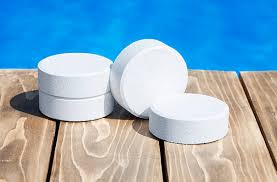Overview
Hypochlorites, the most widely used of the chlorine disinfectants, are available as liquid (e.g., sodium hypochlorite) or solid (e.g., calcium hypochlorite). The most prevalent chlorine products in the United States are aqueous solutions of 5.25%–6.15% sodium hypochlorite (see glossary), usually called household bleach. They have a broad spectrum of antimicrobial activity, do not leave toxic residues, are unaffected by water hardness, are inexpensive and fast acting, remove dried or fixed organisms and biofilms from surfaces, and have a low incidence of serious toxicity.
Sodium hypochlorite at the concentration used in household bleach (5.25-6.15%) can produce ocular irritation or oropharyngeal, esophageal, and gastric burns. Other disadvantages of hypochlorites include corrosiveness to metals in high concentrations (>500 ppm), inactivation by organic matter, discoloring or “bleaching” of fabrics, release of toxic chlorine gas when mixed with ammonia or acid (e.g., household cleaning agents), and relative stability.
The microbicidal activity of chlorine is attributed largely to undissociated hypochlorous acid (HOCl). The dissociation of HOCI to the less microbicidal form (hypochlorite ion OCl-) depends on pH. The disinfecting efficacy of chlorine decreases with an increase in pH that parallels the conversion of undissociated HOCI to OCl–. A potential hazard is production of the carcinogen bis(chloromethyl) ether when hypochlorite solutions contact formaldehyde and the production of the animal carcinogen trihalomethane when hot water is hyperchlorinated. After reviewing environmental fate and ecologic data, EPA has determined the currently registered uses of hypochlorites will not result in unreasonable adverse effects to the environment.
Alternative compounds that release chlorine and are used in the health-care setting include demand-release chlorine dioxide, sodium dichloroisocyanurate, and chloramine-T. The advantage of these compounds over the hypochlorites is that they retain chlorine longer and so exert a more prolonged bactericidal effect. Sodium dichloroisocyanurate tablets are stable, and for two reasons, the microbicidal activity of solutions prepared from sodium dichloroisocyanurate tablets might be greater than that of sodium hypochlorite solutions containing the same total available chlorine.
Chlorine dioxide-based disinfectants are prepared fresh as required by mixing the two components (base solution [citric acid with preservatives and corrosion inhibitors] and the activator solution [sodium chlorite]).
Mode of Action
The exact mechanism by which free chlorine destroys microorganisms has not been elucidated. Inactivation by chlorine can result from a number of factors: oxidation of sulfhydryl enzymes and amino acids; ring chlorination of amino acids; loss of intracellular contents; decreased uptake of nutrients; inhibition of protein synthesis; decreased oxygen uptake; oxidation of respiratory components; decreased adenosine triphosphate production; breaks in DNA; and depressed DNA synthesi. The actual microbicidal mechanism of chlorine might involve a combination of these factors or the effect of chlorine on critical sites.
Microbicidal Activity
Low concentrations of free available chlorine (e.g., HOCl, OCl-, and elemental chlorine-Cl2) have a biocidal effect on mycoplasma (25 ppm) and vegetative bacteria (<5 ppm) in seconds in the absence of an organic load. Higher concentrations (1,000 ppm) of chlorine are required to kill M. tuberculosis using the Association of Official Analytical Chemists (AOAC) tuberculocidal test. A concentration of 100 ppm will kill >99.9% of B. atrophaeus spores within 5 minutes and destroy mycotic agents in <1 hour. Acidified bleach and regular bleach (5,000 ppm chlorine) can inactivate 106 Clostridium difficile spores in <10 minutes. One study reported that 25 different viruses were inactivated in 10 minutes with 200 ppm available chlorine. Several studies have demonstrated the effectiveness of diluted sodium hypochlorite and other disinfectants to inactivate HIV.
Data are available for chlorine dioxide that support manufacturers’ bactericidal, fungicidal, sporicidal, tuberculocidal, and virucidal label claims. A chlorine dioxide generator has been shown effective for decontaminating flexible endoscopes but it is not currently FDA-cleared for use as a high-level disinfectant.
Uses
Hypochlorites are widely used in healthcare facilities in a variety of settings. Inorganic chlorine solution is used for disinfecting tonometer heads and for spot-disinfection of countertops and floors.
Because hypochlorites and other germicides are substantially inactivated in the presence of blood, large spills of blood require that the surface be cleaned before an EPA-registered disinfectant or a 1:10 (final concentration) solution of household bleach is applied. If a sharps injury is possible, the surface initially should be decontaminated, then cleaned and disinfected (1:10 final concentration).
surfaces on the basis of testing methodologies that do not simulate actual disinfection practices. Other uses in healthcare include as an irrigating agent in endodontic treatment and as a disinfectant for manikins, laundry, dental appliances, hydrotherapy tanks, regulated medical waste before disposal, and the water distribution system in hemodialysis centers and hemodialysis machines Chlorine long has been used as the disinfectant in water treatment. Chlorine long has been used as the disinfectant in water treatment.
Thursday, June 3, 2021
Refrences
Please Check out file at the following link
How long should sterilization monitoring records be maintained?


